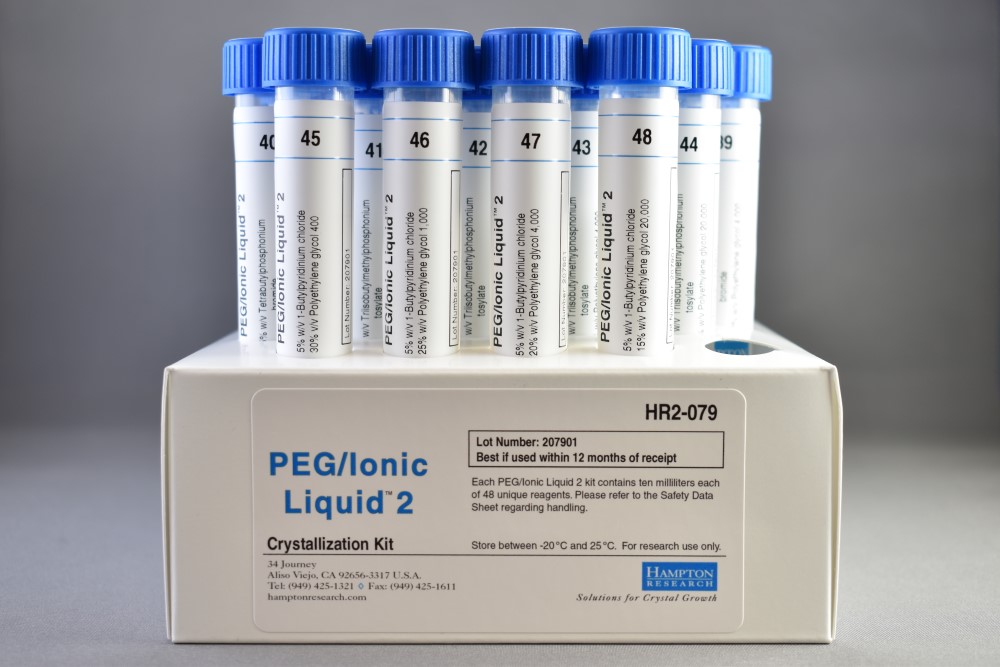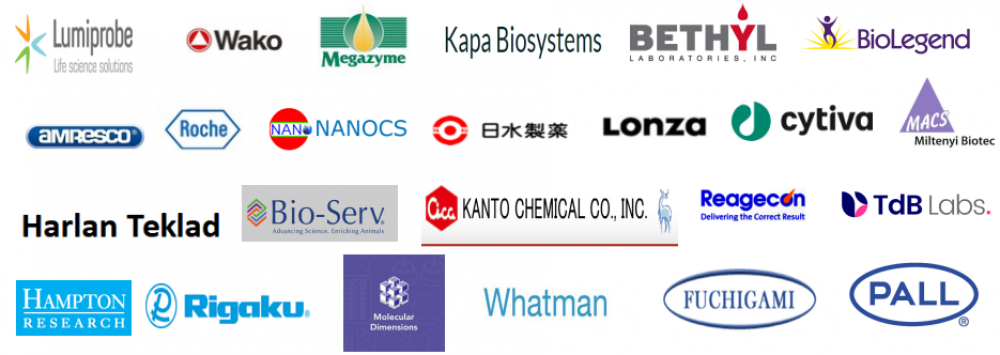PEG/Ionic Liquid 1 • PEG/Ionic Liquid 2蛋白结晶-Hampton
上海金畔生物代理Hampton research品牌蛋白结晶试剂耗材工具等,我们将竭诚为您服务,欢迎访问Hampton research官网或者咨询我们获取更多相关Hampton research品牌产品信息。


Products > Crystallization Screens > PEG/Ionic Liquid 1 • PEG/Ionic Liquid 2 • PEG/Ionic Liquid HT > PEG/Ionic Liquid 1 • PEG/Ionic Liquid 2
PEG/Ionic Liquid 1 • PEG/Ionic Liquid 2
Applications
Crystallization screen for biological macromolecules, where Polyethylene glycols are are the primary, and ionic liquid the secondary reagent, sampling a broad range of pH without an added buffer.
Features
- Samples a broad range of pH without an added buffer
- Polyethylene glycol 400, 1,000, 4,000, & 20,000 – primary reagent
- 24 unique ionic liquids – secondary reagent (when using both PEG/Ionic Liquid 1 & 2 or PEG/Ionic Liquid HT)
- Vapor diffusion, microbatch, free interface diffusion
Description
Ionic liquids have been found effective as additives in protein crystallization, with different ionic liquids used to increase crystallization rates and crystal size.1-4 The inclusion of ionic liquids in crystallization experiments has been reported to lead to less crystal polymorphism as well as less precipitation at higher precipitant concentrations.2,5 Ionic liquids have been used as additives to produce crystals in reagents that had previously not resulted in crystallization and results suggest ionic liquids may be applicable for the solubilization and crystallization of membrane proteins.2
Ionic liquids are organic salts with melting points below 100°Celsius. They are thermally stable, nonflammable and demonstrate very low vapor pressure. Ionic liquids are soluble in a variety of organic and inorganic reagents and can be highly water soluble. Ionic liquids can demonstrate a degree of localized structuring about each ion compared to materials composed of disassociated ions, setting them apart from salt solutions.5,6 Ionic liquids can participate in ionic, hydrophobic and hydrogen bond interactions. Ionic liquids are often chaotropic, composed of low symmetry ions with charge delocalization and weak intermolecular interactions.1 These organic salts generally consist of combinations of organic cations and either an organic or inorganic anion. Ionic liquids have been demonstrated to suppress protein aggregation and significantly increase protein folding yields.7,8 Ionic liquids have been reported to stabilize protein activity and structure.9-11 The inclusion of the ionic liquid 1-n-Butyl-3-methylimidazolium tetrafluoroborate improved the thermal stability and solubility of integral membrane proteins for membrane proteomics study.12
Some ionic liquids, such as ethylammonium nitrate have water-like characteristics, including the capacity for hydrogen bonding and the promotion of micelle formation by some surfactants.13 Many ionic liquids are also organic acids and have ionic character in addition to the hydrophobic behavior, which makes them unique and useful solvents in protein chemistry.
Variation of the anion and the cation as well as the utilization of both soft (formate and acetate) and hard anions (nitrate) in the reagents provides an additional dimension for evaluating the effects on ionic liquids on the solubility and crystallization of proteins. The screen contains 24 water soluble ionic liquids that comprise different cation (ammonium, cholin, imidazolium, phosphonium, and pyridinium) and anion (bromide, chloride, formate, nitrate, acetate, phosphate, cyanamide, sulfate, fluoroborate, fluoroacetate, sulfonate, and tosylate) structures for a diverse PEG and Ionic Liquid formulation for use in the crystallization screening of biological macromolecules.
PEG/Ionic Liquid HT samples four different low molecular weight Polyethylene glycols (400, 1,000, 4,000, and 20,000) versus twenty four ionic liquids, encompassing a broad range of pH without an added buffer. PEG/Ionic Liquid HT is supplied in a 96 Deep Well block format and is compatible with robotic and multi-channel pipet liquid handling systems. PEG/Ionic Liquid HT is compatible with vapor diffusion, free interface diffusion, and microbatch crystallization methods. For research use only.
生物大分子的结晶筛选,其中聚乙二醇是主要试剂,离子液体是次要试剂,在不添加缓冲液的情况下对广泛的 pH 值范围进行采样。特征
无需添加缓冲液即可对各种 pH 值进行采样
聚乙二醇 400、1,000、4,000 和 20,000 – 主要试剂
24 种独特的离子液体 – 辅助试剂(当同时使用 PEG/Ionic Liquid 1 & 2 或 PEG/Ionic Liquid HT 时)
蒸气扩散、微批次、自由界面扩散
描述
已发现离子液体可有效作为蛋白质结晶的添加剂,使用不同的离子液体可提高结晶速率和晶体尺寸。 1-4 据报道,在结晶实验中加入离子液体可导致较少的晶体多态性和较少的沉淀在更高的沉淀剂浓度下。2,5 离子液体已被用作添加剂以在以前不会导致结晶的试剂中产生晶体,结果表明离子液体可能适用于膜蛋白的增溶和结晶。 2
离子液体是熔点低于 100°C 的有机盐。它们具有热稳定性、不可燃性和极低的蒸气压。离子液体可溶于多种有机和无机试剂,并可高度溶于水。与由离解离子组成的材料相比,离子液体可以展示每个离子一定程度的局部结构,将它们与盐溶液区分开来。5,6 离子液体可以参与离子、疏水和氢键相互作用。离子液体通常是离液的,由具有电荷离域和弱分子间相互作用的低对称离子组成。1 这些有机盐通常由有机阳离子和有机或无机阴离子的组合组成。离子液体已被证明可抑制蛋白质聚集并显着增加蛋白质折叠产率。7,8 据报道,离子液体可稳定蛋白质活性和结构。9-11 离子液体 1-n-Butyl-3-methylimidazolium 四氟硼酸盐的加入提高了膜蛋白质组学研究中完整膜蛋白的热稳定性和溶解性。 12
一些离子液体,如硝酸乙基铵,具有类似水的特性,包括氢键的能力和一些表面活性剂促进胶束形成的能力。 13 许多离子液体也是有机酸,除了疏水行为外还具有离子特性,这使它们成为蛋白质化学中独特而有用的溶剂。
阴离子和阳离子的变化以及试剂中软阴离子(甲酸盐和乙酸盐)和硬阴离子(硝酸盐)的使用为评估离子液体对蛋白质溶解度和结晶的影响提供了额外的维度。该屏幕包含 24 种水溶性离子液体,包括不同的阳离子(铵、胆碱、咪唑鎓、鏻和吡啶)和阴离子(溴化物、氯化物、甲酸盐、硝酸盐、乙酸盐、磷酸盐、氰胺、硫酸盐、氟硼酸盐、氟乙酸盐、磺酸盐和甲苯磺酸盐)结构,用于多种 PEG 和离子液体制剂,用于生物大分子的结晶筛选。
PEG/离子液体 HT 对四种不同的低分子量聚乙二醇(400、1,000、4,000 和 20,000)与 24 种离子液体进行采样,涵盖广泛的 pH 范围,无需添加缓冲液。 PEG/Ionic Liquid HT 以 96 Deep Well 模块形式提供,与机器人和多通道移液管液体处理系统兼容。 PEG/Ionic Liquid HT 与蒸汽扩散、自由界面扩散和微批次结晶方法兼容。仅供研究使用。
PEG/Ionic Liquid






CAT NO
HR2-078
NAME
DESCRIPTION
10 ml, tube format
PRICE
$253.00
cart quote
CAT NO
HR2-079
NAME
DESCRIPTION
10 ml, tube format
PRICE
$253.00
cart quote
CAT NO
HR2-462
NAME
DESCRIPTION
1 ml, Deep Well block format
PRICE
$147.00
cart quote
Support Material(s)
 HR2-078 PEG/Ionic Liquid 1 Documents
HR2-078 PEG/Ionic Liquid 1 Documents HR2-078 PEG/Ionic Liquid 1 SDS
HR2-078 PEG/Ionic Liquid 1 SDS HR2-079 PEG/Ionic Liquid 2 Documents
HR2-079 PEG/Ionic Liquid 2 Documents HR2-079 PEG/Ionic Liquid 2 SDS
HR2-079 PEG/Ionic Liquid 2 SDS HR2-462 PEG/Ionic Liquid HT Documents
HR2-462 PEG/Ionic Liquid HT Documents HR2-462 PEG/Ionic Liquid HT SDS
HR2-462 PEG/Ionic Liquid HT SDS PEG/Ionic Liquid Formulation & Scoring Data
PEG/Ionic Liquid Formulation & Scoring DataReferences
1. Introduction to protein crystallization. Alexander McPherson and Jose A. Gavira. Acta Crystallographica Section F Volume 70, Issue 1, pages 2–20, January 2014.
2. Optimization of crystallization conditions for biological macromolecules. Alexander McPherson and Bob Cudney. Acta Crystallographica Section F Volume 70, Issue 11, pages 1445–1467, November 2014.
3. Pusey, M.L., Paley, M.S., Turner, M.B., and Rogers, R.D. 2007. Protein crystallization using room temperature ionic liquids. Crystal Growth & Design. 74:787-793.
4. Hekmat, D., Hebel, D., Sebastian, J. Schmidt, M., and Weuster-Botz, D. 2007. Advanced protein crystallization using water-soluble ionic liquids as crystallization additives. Biotech. Lett., 29:703-1711.
5. Garlitz, J.A., Summers, C.A., Flowers, R.A. and Borgstahl, G.E.O. 1999. Ethylammonium nitrate: A protein crystallization reagent. Acta Cryst. D53:2037-2038.
6. Judge, R.A., Takahashi, S., Longnecker, K.L. Fry, E.H., Abad-Zapatero, C., and Chi, M.L. 2009. The effects of ionic liquids on protein crystallization and X-ray diffraction resolution. Crystal Growth & Design 9:3463-3469.
7. Bowran, D.T., Hardacre, C. Holbrey, J.D., McMath, J.E., and Soper, A.K. 2003. J. Chem. Phys. 118:173-178.
8. Cadena, C., Zhao, Q., Snurr, and R.Q., Maginn, E.J. 2006. J. Chem. Phys. B 110:2821-2832.
9. Summers, C.A. and Flowers, R.A. 2000. Protein renaturation by the liquid organic salt ethylammonium nitrate. Protein Science 9:2001-2008.
10. Lange, C., Patil, G., and Rudolph, R. 2005. Ionic liquids as refolding additives: N’-alkyl and N’-(w-hydroxyalkyl) N-methylimidazolium chloride. Protein Science 14:2693-2701.
11. Lozano, P. , de Diego, T. Guegan, J.P., Vaultier, M., and Ibora, J.L. 2001. Stabilization of a-chymotrypsin by ionic liquids in transesterification reactions. Biotehnol. Bioeng. 75:363-369.
12. Baker, S.N., McCleskey, T.M., Pandy, S., and Baker, G.A. 2004. Fluorescence study of protein thermostability in ionic liquids. Chem. Commun. 2004:940-941.
13. De Diego, T., Lozano, P., Gmouth, S. Vaultier, M., and Iborra, J.L. 2004. Fluorescence and CD spectroscopic analysis of the a-chymotrypsin stabilization by the ionic liquid 1-ethyl-3-methyimidazolium bis[(trifluormethyl)sulfonyl]amide. Biotechnol. Bioeng. 88:916-924.
14. Sun, L., Tao, D., Han, B., Ma, J., Zhu, G., Liang, Z., Shan, Y., Zhang, L., and Zhang, Y. 2010. Ionic liquid 1-butyl-3-methyl imidazolium tetrafluoroborate for shotgun membrane proteomics. Anal. Bioanal. Chem. DOI 10.1007/s0216-010-4381-5.
15. Evans, D.F., Yamauchi, A., Roman, R., and Casassa, E.Z. 1982. J. Colloids Interface Sci. 88:89-96.
16. Proteins in Ionic Liquids: Current Status of Experiments and Simulations. Christian Schröde, Top Curr Chem (J). 2017; 375(2): 25.
17. Ionic Liquids as Stabilization and Refolding Additives and Solvents for Proteins. Fujita K. Adv Biochem Eng Biotechnol. 2018 Jul 13. doi: 10.1007/10_2018_65.
18. Fujita K. (2018) Ionic Liquids as Stabilization and Refolding Additives and Solvents for Proteins. In: . Advances in Biochemical Engineering/Biotechnology. Springer, Berlin, Heidelberg.
